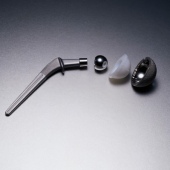
TUESDAY, Jan. 17 (HealthDay News) — One of every 100 people undergoing knee replacement surgery and 1 of 200 people having hip replacement surgery will develop a blood clot before they leave the hospital, even if they take steps to prevent the development of these blood clots, a new evidence review suggests.
A deep venous thrombosis (DVT) or blood clot can form deep within the veins, usually in the leg. The real risk occurs if these blood clots dislodge, travel through your bloodstream, and block blood flow in your lungs, which is called pulmonary embolism.
The new study, published in the Jan. 18 Journal of the American Medical Association, seeks to provide a reliable benchmark of this risk, but many experts in the field worry that the actual risk of blood clots after joint replacement is really much higher than this study suggests.
Researchers led by Jean-Marie Januel, of the Lausanne University Hospital, in Switzerland, analyzed 47 studies comprising nearly 45,000 joint replacement cases. All patients received preventive measures to lower their risk of developing a blood clot. Despite this treatment, one in every 100 patients undergoing knee replacement and 1 in every 200 patients undergoing hip replacement developed a blood clot before hospital discharge. Prevention typically involves getting patients moving soon after surgery, providing compression stockings or boots and administering some type of medication that prevents clots from forming.
Dr. John Heit, a cardiologist at the Mayo Clinic in Rochester, Minn., wrote an editorial accompanying the new report.
“The authors are trying to estimate the magnitude of the problem among patients who receive the most effective prophylaxis available today,” Heit said. But the risk is actually much higher than the study suggests, he said. “One has to understand the period of risk extends beyond the duration of hospitalization, which these days, is really quite short.”
He added, “Orthopedic surgeons are very aware of this problem and do an excellent job in choosing patients that are most likely to benefit from surgery, and they are very religious in terms of providing some form of prophylaxis after surgery.”
Dr. Joel Buchalter, an orthopedic surgeon at Somers Orthopaedic Surgery and Sports Medicine Group in Carmel, N.Y., agreed. He said that the risk of blood clots after joint replacement surgery may be even higher. The new study looked only at patients who developed blood clots in the hospital, but these blood clots can develop weeks after the surgery, he said.
Signs of a blood clot may include swelling, tenderness and pain when flexing the ankle, Buchalter said. “If a person has any of these symptoms, an ultrasound exam can rule a blood clot in or out, but many times blood clots have no symptoms. Some people have a great-looking leg and have a blood clot and don’t even know it,” he said.
Dr. Mathias Bostrom, an orthopedic surgeon at the Hospital for Special Surgery in New York City, said that the risk for blood clots after a joint replacement is real. “The new study once again reinforces that even in 2012, the risk of blood clots after total knee or hip replacement surgery is significant,” Bostrom said. There are many new drugs available today to help lower risk for blood clots after surgery, but these do have risks of their own, he said.
More information
Learn more about deep vein thrombosis at the American Academy of Orthopaedic Surgeons.

